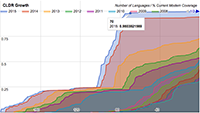![Adlam Sample Image [Adlam Sample Image]](http://www.unicode.org/announcements/new-repertoire-5cd.jpg)
Mountain View, CA, USA – The Unicode® Consortium today announced the start of
the beta review for the forthcoming Unicode 9.0.0, which is scheduled for
release in June, 2016. All beta feedback must be submitted by May 2, 2016.
Unicode is the foundation for all modern software and communications around
the world, including all modern operating systems, browsers, laptops, and smart
phones – plus the Internet and Web (URLs, HTML, XML, CSS, JSON, etc.). Thus it
is important to ensure a smooth transition to each new version of the Unicode
Standard.
Unicode 9.0.0 comprises several additions and changes which require careful
migration in implementations. These include asymmetric case mappings, numerous
variation sequences, new fractional numeric values, and changes to property
values, especially East_Asian_Width values. The line breaking and text
segmentation algorithms handle character sequences that represent emoji as
indivisible units via the addition of new property values and rules.
Implementers need to modify code and check assumptions for all affected
processes to support these additions and changes.
The new character repertoire includes 74 emoji symbols, 19 symbols used in
Japanese TV broadcasting, and multiple additions to existing scripts. There are
six new scripts, of which three are in modern use (Adlam, Osage, and Newa) and
three are historic (Bhaiksuki, Marchen, and Tangut). Adlam and Osage have case
pairs and require data updates for casing functions. Tangut is a large
ideographic script whose addition incurred changes to the Unicode Collation
Algorithm (used as the basis for sorting text in all languages).
Please review the documentation, adjust your code, test the data files, and
report errors and other issues to the Unicode Consortium by May 2, 2016.
Feedback instructions are on the beta page.
See
http://unicode.org/versions/beta-9.0.0.html
for more information about testing the 9.0.0 beta.
See
http://unicode.org/versions/Unicode9.0.0/
for the current draft summary of Unicode 9.0.0.
About the Unicode Consortium
The Unicode Consortium is a non-profit organization founded to develop,
extend and promote use of the Unicode Standard and related globalization
standards. The membership of the consortium represents a broad spectrum of
corporations and organizations, many in the computer and information processing
industry. Members include: Adobe, Apple, Emoji One, EmojiXpress, Facebook,
Google, Government of Bangladesh, Government of India, Huawei, IBM, Microsoft,
Monotype Imaging, Sultanate of Oman MARA, Oracle, SAP, Tamil Virtual University,
The University of California (Berkeley), Yahoo!, plus well over a hundred
Associate, Liaison, and Individual members. For more information, please contact
the Unicode Consortium
http://www.unicode.org/contacts.html.
 Unicode CLDR 29 provides an update to the key building blocks for software
supporting the world's languages. This data is used by all
major software
systems for their software internationalization and localization, adapting
software to the conventions of different languages for such common software
tasks. The following summarizes the main improvements in the release.
Unicode CLDR 29 provides an update to the key building blocks for software
supporting the world's languages. This data is used by all
major software
systems for their software internationalization and localization, adapting
software to the conventions of different languages for such common software
tasks. The following summarizes the main improvements in the release.
![[IUC 40 Banner]](http://www.unicodeconference.org/_borders/main-2016.jpg)
![Adlam Sample Image [Adlam Sample Image]](http://www.unicode.org/announcements/new-repertoire-5cd.jpg) Mountain View, CA, USA – The Unicode® Consortium today announced the start of
the beta review for the forthcoming Unicode 9.0.0, which is scheduled for
release in June, 2016. All beta feedback must be submitted by May 2, 2016.
Mountain View, CA, USA – The Unicode® Consortium today announced the start of
the beta review for the forthcoming Unicode 9.0.0, which is scheduled for
release in June, 2016. All beta feedback must be submitted by May 2, 2016.